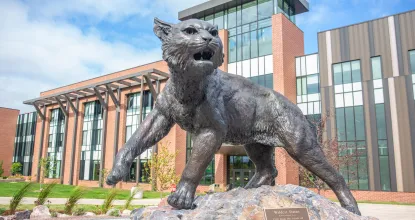
A History of Native American Initiatives at Northern Michigan University
Martin Reinhardt, Russell Magnaghi, and Tina Moses
with additional contributions by April Lindala, Dan Truckey and Aimée Cree Dunn
Introduction
The history of Native American initiatives at Northern Michigan University can be found in many places. Some pieces of this historic puzzle are located in the file drawers of the Center for Native American Studies (Center), some are on the Center’s website, and some are found within the historical summaries of those who have been piecing it together off and on for years (for example, see Russell Magnaghi’s Native Americans of Michigan's Upper Peninsula: A Chronology to 1900). Perhaps the best historical repository is that of the people who were part of that history themselves (for example see taped interviews deposited in the Central Upper Peninsula and Northern Michigan University Archives). Sitting down with the people who have been part of the NMU community in some way, shape, or form reveals stories that interweave the facts with people’s lives and legacies.
What follows is a glimpse of this history, shared based on the memories and experiences of the primary authors and other contributors. For the purpose of this essay, Native American initiatives are defined broadly including people, events, programs, policies, etc. Omissions of names, dates, and events are not intentional. The authors would appreciate learning about missing pieces and making corrections to this living document.
The three primary authors have been affiliated with the Center for Native American Studies over the years as faculty, staff, students, or community members. Additional contributors and editors to this piece have also worked in the Diversity Student Services Office and served leadership roles with local community organizations such as the Native Americans of Marquette County, Inc. and the American Indian Coordinating Council of Marquette.
Land Acknowledgement, Origins, and Relations
In this era of decolonization and revitalization, it is important to acknowledge the relationship between Northern Michigan University and the land upon which it exists; what is currently recognized by many as the central part of Michigan’s Upper Peninsula. It is also important to recognize the cultural traditions from which the University originates and how it has since evolved.
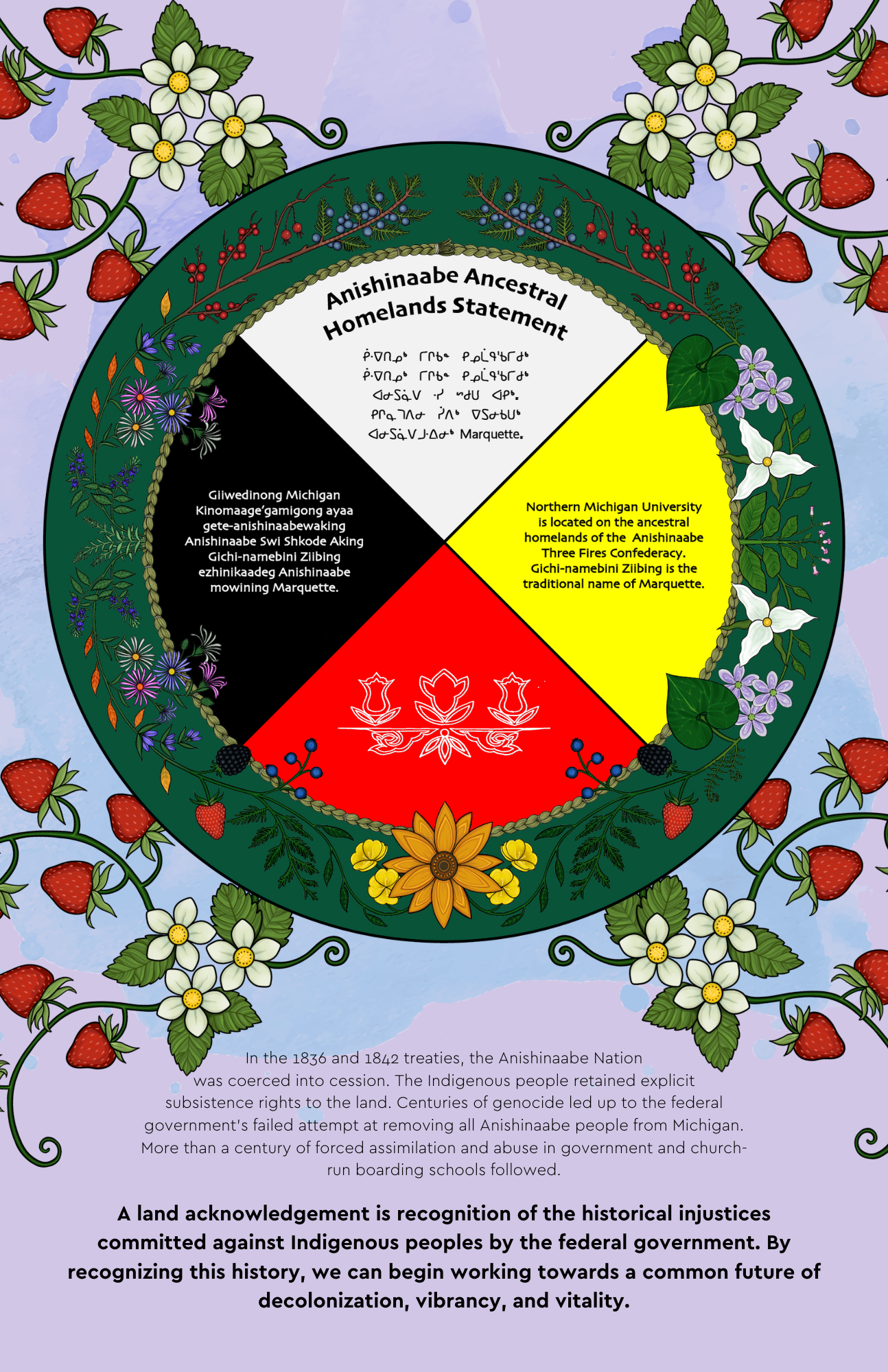
Long before the existence of the United States of America and Canada, the Indigenous peoples of this continent had their own names for this place they call home. Many refer to this planet as Mother Earth and the North American continent as Turtle Island. Anishinaabe Aking, the lands of the Anishinaabe Three Fires Confederacy of Ojibway, Odawa, and Potawatomi, stretch across and beyond the Great Lakes Region, including Marquette, Michigan.
According to Magnaghi (1999), the area now known as Marquette, Michigan has been home to Indigenous peoples since the retreat of the glaciers from this area after the last ice age (p.67). He states, “Between the mouth of the Chocolay River and Presque Isle, there were at least 6 Indian villages” (p.67). He goes on to say that “an old 1857 map shows that an Indian trail passed from downtown Marquette, probably along the high ground of the campus, and then headed north” (p.68). In 2007, the Great Lakes Indian Fish & Wildlife Commission produced a map showing some of the original Anishinaabe names of village sites and other prominent features of this area. Undoubtedly, the most prominent feature of this area is Anishinaabek Gichigami, also known as Lake Superior.
Archaeological evidence of Indigenous peoples’ presence in this area has dated as far back as 8,500-7,000 BCE (Before Common Era) at an area known as the Silver Lake Basin just west of present-day Marquette. More recent archaeological evidence comes from what is known as the Mesnard site just southeast of Marquette. This site dates back to 3,500-500 BCE and provided evidence of a large quartzite quarry as well as copper artifacts during the late Archaic period. At the same time, Indigenous people occupied a large campsite or village on Presque Isle. Quartzite and copper tooling were considered one of the largest prehistoric occupations in this area.
According to the Great Lakes Indian Fish & Wildlife Commission (2007), Gichinamebine-Ziibing (Place of the Great Sucker Fish River) is the original name of the village that was located near the Mesnard site. The village was near the mouth of what is now known as the Carp River. This was the largest village site in the area when Europeans first traveled here. Besides the connection with the ancient quartzite quarry, the village had the largest traditional Indigenous garden in the area. It now sits under a prison and water treatment facility as well as bike paths and hiking trails. The Carp River and the Carp River Trail connected Gichnamebine-Ziibing with the Zhooshkwaanibkaag-Ziibi or what is known today as the Escanaba River at the forks in what is now called Gwinn. It would have taken several days walking along this route to reach Flat Rock, or what is known today as Escanaba, on the shores of Lake Michigan.
The United States entered into multiple treaties with the Anishinaabe Three Fires Confederacy. Several of those treaties secured the land base on which the State of Michigan now exists. On May 27, 1836, the United States signed the Treaty of Washington, also known as the Treaty with the Ottawa, Etc. This treaty ceded nearly 14 million acres of land in the northern Lower Peninsula and eastern Upper Peninsula of Michigan. Soon after, on January 26, 1837, the State of Michigan was granted statehood. Although the main NMU campus sits west of the 1836 treaty ceded area boundary, NMU does own a golf course that sits on the east side of the line within the 1836 area.
On October 4, 1842, the United States entered into another treaty with the Anishinaabe called the Treaty of La Pointe. This treaty was also called the Treaty with the Chippewa, and ceded another major tract of land that extends from the central Upper Peninsula of Michigan into what is now known as the State of Wisconsin. Northern Michigan University (NMU) was founded in 1899 on Anishinaabe land within the 1842 treaty ceded area. This was one year before the 1900 US Census in which it was estimated that the American Indian population was at its lowest in history numbering only about 248,253.
The original site of NMU was located on the north side of Marquette, adjacent to “marsh ground, saturated with cold spring water. This land was enveloped in fog almost every summer evening” (Magnaghi, 1999, p.71). Although it is pure speculation on the author’s part, it is not a stretch of the imagination to assume that this prominent marsh area would have played a vital role in local Anishinaabe culture. The Anishinaabemowin term for marsh is mashkiig (Ojibwe People’s Dictionary, 2019). This contains the same root as the term mashkiki, a term meaning medicine (Ojibwe People’s Dictionary, 2019). It is no accident that these terms are similar given the significant relationship between marshes and some of the most important traditional medicines of the Anishinaabek.
The early years of NMU are juxtaposed with some of the most damaging ideologies and federal policies ever regarding American Indian people. The disenfranchisement of Native people from their traditional homelands, the degradation of natural resources in their subsequent reservation communities, and their forced assimilation through Western educational institutions and churches all served to undermine Native cultural traditions and wreaked havoc on their health and welfare.
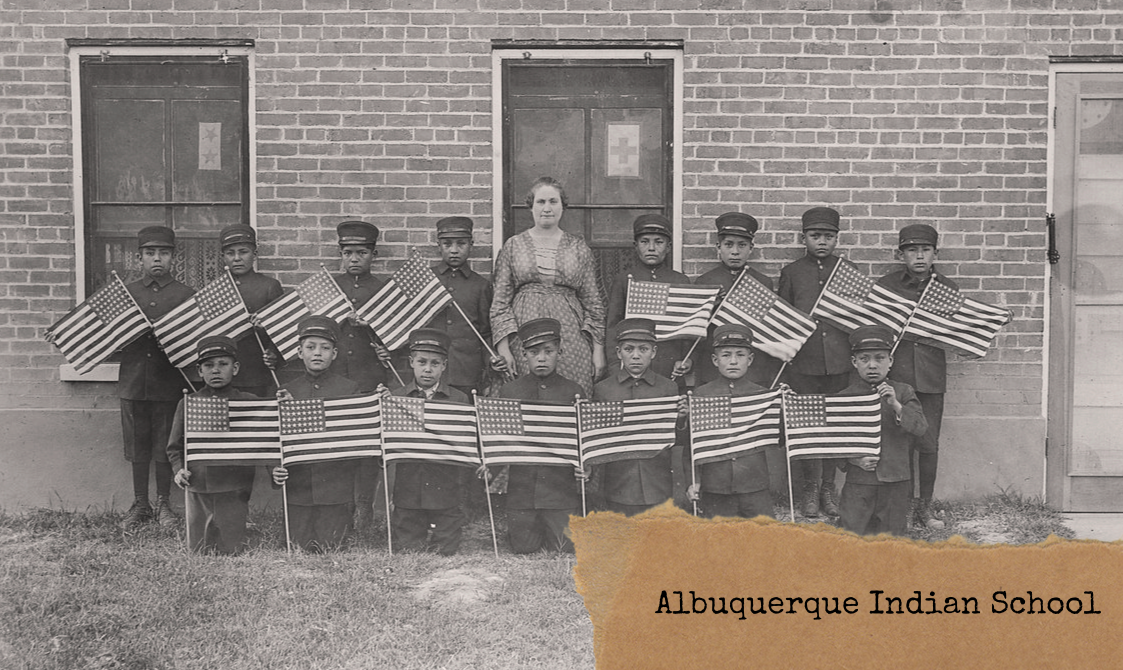
One of the most devastating policies ever leveled against the Indigenous peoples of this continent by the United States was forced assimilation largely practiced through the American Indian boarding school initiative. In the U.S., by 1913, there were 69 Indian mission schools in operation, and 328 Indian government schools which included 217 day schools, 76 reservation boarding schools, and 35 off-reservation boarding schools (Reinhardt, 1998, p.72).
In Michigan, there were at least five entities that could fit the definition of a boarding school for Indian children. These include the Holy Childhood of Jesus School, Holy Name Mission, Mount Pleasant Indian Industrial Boarding School, Ursuline Academy, and the Holy Family (aka Holy Cross) Orphanage. Note that the Holy Family Orphanage was located in Marquette and was in operation from 1915-1967. There were also eight Indian day schools in Michigan. “These included the Garden Island Day School, the Nawbetung Day School, the Longwood Day School, the Chippewa Day School, the Neppessing Day School, the Hannahville Indian Mission Day School, the L’Anse Indian Day School, and the Sugar Island Indian Day School” (Reinhardt, 1998, p.66).
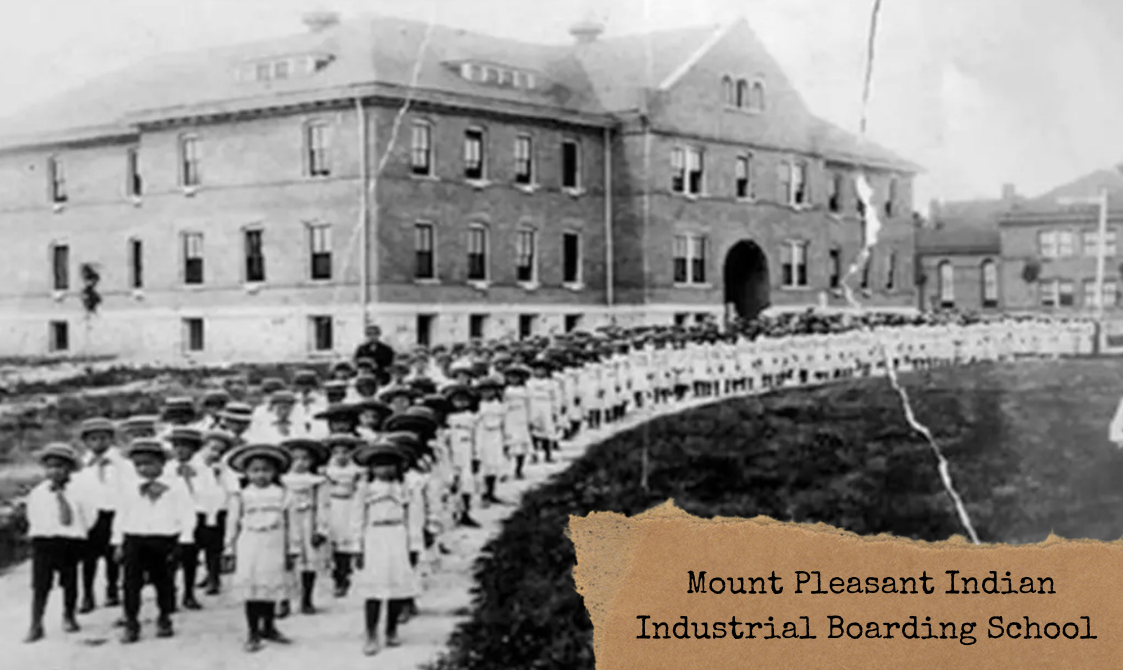
It was a common practice to recruit new graduates from local colleges to teach in Indian schools at that time. While the employment of NMU graduates at the schools listed above has yet to be properly researched, it can be assumed that at least some of the teachers working at Indian boarding schools in Michigan and elsewhere were likely former NMU students. As such, it is difficult not to assume that whatever these teachers were learning about education at NMU had an impact on Indian students at these schools.
Early Interactions at NMU
Besides producing teachers that may have taught at Indian schools, there was very little activity at NMU that focused on the American Indian community between 1899 and the mid-1960s. According to Magnaghi (1999), the earliest and only record of any such activity during this period was in 1936 when the University brought Charles Eagle Plume in to do a presentation called “Making Medicine,” which included Native song and dance (p.290). This period was referred to as “The Abyss” by former Bureau of Indian Affairs Michigan Education Officer Robert Van Alstine, who was also one of the first Native Alumni of NMU. This was similar to what was happening at the State level, which may have been due to the Comstock Agreement of 1934.
In 1957, Superintendent of the Great Lakes Indian Agency, Emmett J. Riley explained “there [had] been no federal services rendered to Indians in Michigan since 1932, except to keep their lands in restricted status” (EN, Jun. 19, 1957). Again in 1965, during a conference at Northern Michigan University attended by tribal chiefs; federal, state and county representatives; and BIA officials, Superintendent Riley explained that the “BIA [had] been phasing out our activities in the state, because at that time Gov. William A. Comstock indicated the state would shoulder a larger share of caring for its Indians.... Our job in this state for the past several decades had been little more than custodian of lands making up the four reservations in the state” (EN, Sep. 17, 1965).
In August of 1968 at a Michigan Commission on Indian Affairs meeting at Lake Superior State University, Superintendent Riley made suggestions for the “support and organization in college education” (EN, Aug. 13, 1968) for Michigan Indian students. He compared Michigan, with only twenty-three Indian college students, to the other states located in the Great Lakes area, and suggested “that it was the only state that doesn’t come in on education” (EN, Aug. 13, 1968). Wisconsin had sixty-six Indian students enrolled in college the same year, all with scholarships.
Magnaghi reports that “by the fall of 1971, there were twenty-three Native students on campus. By 1977, there were forty-six students enrolled in the Native American Program” (p.290). It is uncertain if the twenty-three students enrolled at NMU in 1971 were the same twenty-three as those cited by Superintendent Riley in 1968, but they certainly could be.
Anishinaabe News
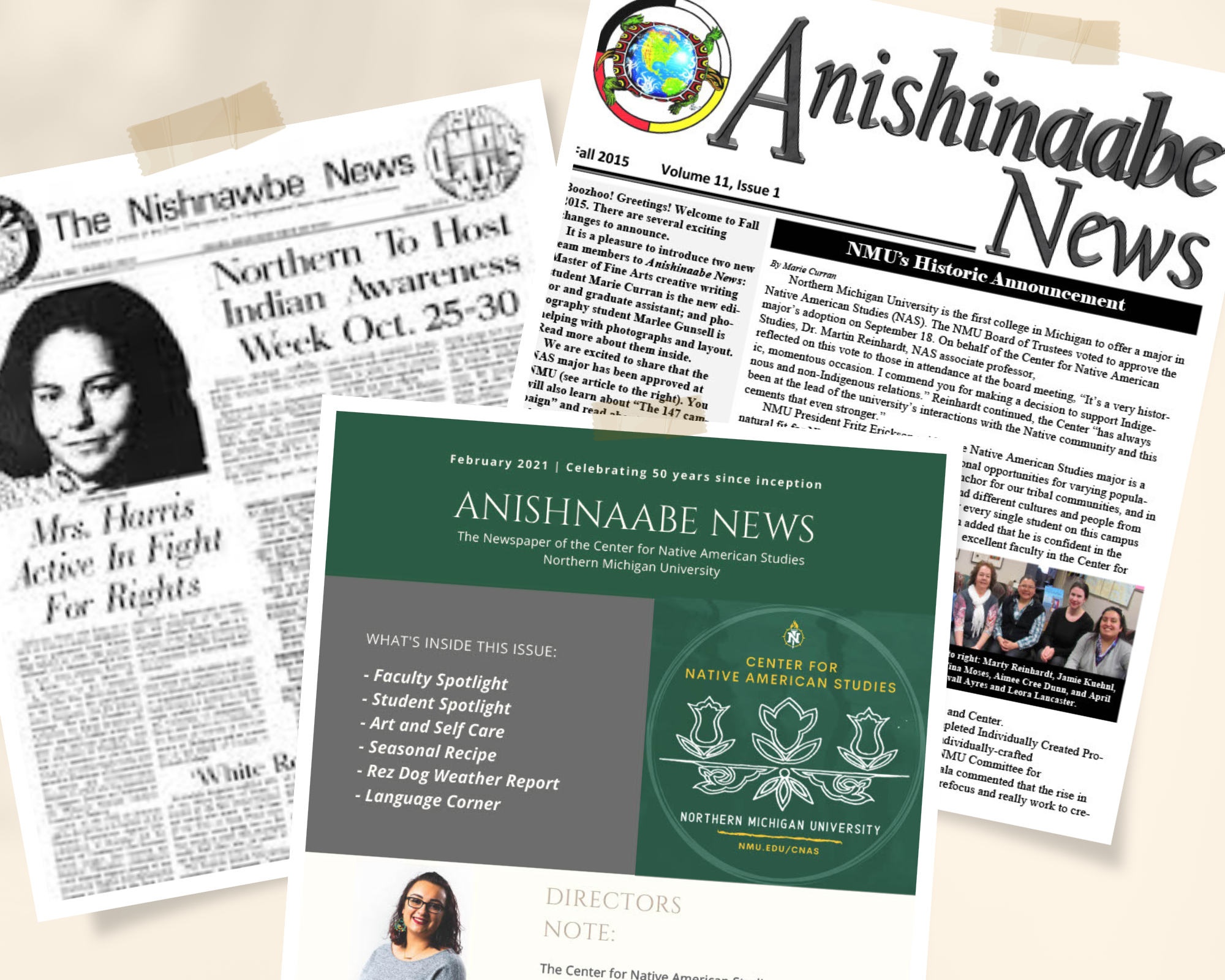 According to Magnaghi (1999), “Between 1971 and 1983, {Jim} Carter and the Native students developed the very successful Nishnawbe News” (p. 291) (now Anishinaabe News). Circulation of the Nishnawbe News reached 6000 subscribers across the United States. In September of 1972, Michael Wright, who was the editor of Nishnawbe News, was appointed to the American Indian Press Association’s board of directors (EN, Sep. 26, 1972). Wright was an Anishinaabe Ojibway from Sault Ste. Marie, Michigan and was selected to serve as a representative of the Great Lakes Region due to his accomplishments with the university publication (EN, Sep. 26, 1972). In 2001, an online format of Anishinaabe News returned under the direction of Martin Reinhardt. In 2005, under the direction of April Lindala, the Anishinaabe News returned as a student-run paper and was offered in a print format and available online until 2016. In 2016, April Lindala and Nicole Walton created Anishinaabe Radio News, a co-production of the Center and Public Radio 90, WNMU-FM. In 2020, director Amber Morseau brought back the Anishinaabe News as the publication embarked on its 50th year since inception in 2021.
According to Magnaghi (1999), “Between 1971 and 1983, {Jim} Carter and the Native students developed the very successful Nishnawbe News” (p. 291) (now Anishinaabe News). Circulation of the Nishnawbe News reached 6000 subscribers across the United States. In September of 1972, Michael Wright, who was the editor of Nishnawbe News, was appointed to the American Indian Press Association’s board of directors (EN, Sep. 26, 1972). Wright was an Anishinaabe Ojibway from Sault Ste. Marie, Michigan and was selected to serve as a representative of the Great Lakes Region due to his accomplishments with the university publication (EN, Sep. 26, 1972). In 2001, an online format of Anishinaabe News returned under the direction of Martin Reinhardt. In 2005, under the direction of April Lindala, the Anishinaabe News returned as a student-run paper and was offered in a print format and available online until 2016. In 2016, April Lindala and Nicole Walton created Anishinaabe Radio News, a co-production of the Center and Public Radio 90, WNMU-FM. In 2020, director Amber Morseau brought back the Anishinaabe News as the publication embarked on its 50th year since inception in 2021.
Native American Student Association
The Native American Student Association (NASA) began in 1993 as the Anishinaabe Club and later transitioned into NASA in 1996. Among the groups first activities was coordinating an annual pow wow (see next section).
NASA membership has waxed and waned over the years, including both Native and non-Native students among the members. The group has generally focused on cultural and academic programming as well as social activities, although it has also acted as an advocate on various issues impacting Native students or the larger Indigenous community. The group has recently rewritten its bylaws to reflect a decolonized governance structure.
Besides the annual pow wow, other events and activities that NASA has either generated or been a major partner in have included:
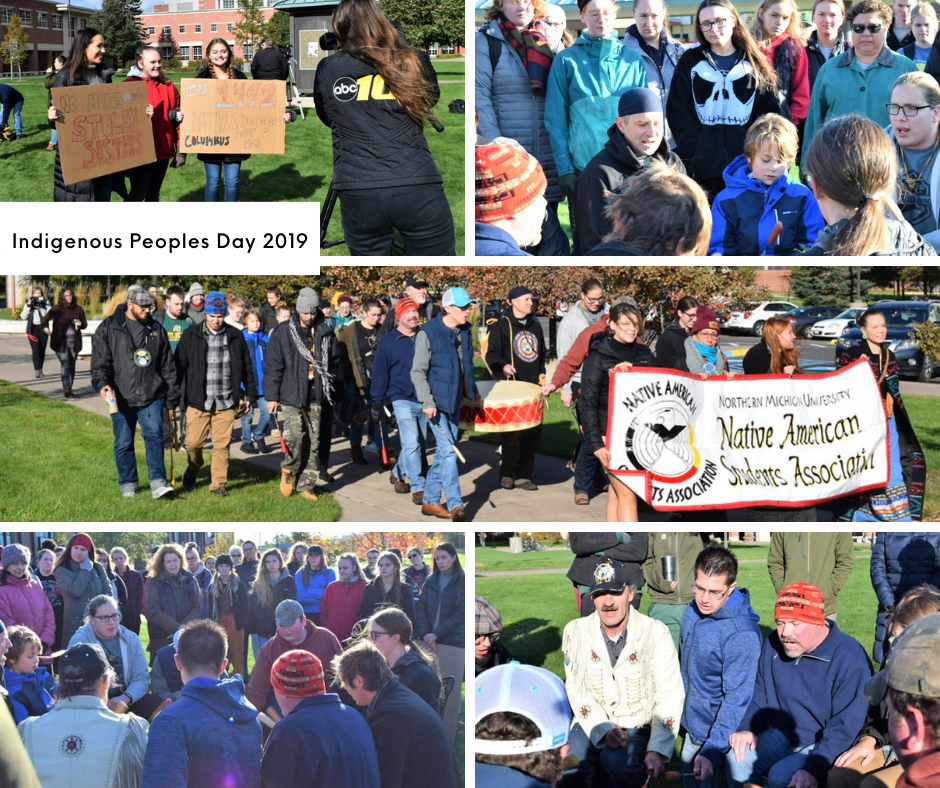
- The First Nations Food Taster: In 2001, NASA began a new tradition at NMU by offering the Anishinaabe Food Taster (later called the First Nations Food Taster) which was a fund raiser for the pow wow.
- Indigenous Peoples Day: On Monday, October 12, 2015, NASA held a petition on the academic mall to formally request NMU to rescind recognition of Columbus Day in favor of Indigenous Peoples Day on the second Monday of each October. The proposal gained the support of NASA and was sent on to ASNMU, the Academic Senate, and the President’s Council, all of which eventually supported the effort. It stalled at the NMU Board of Trustees level until 2021 when it was officially added to the NMU calendar.
- Land Acknowledgement Sign: NASA was also involved in the development of a land acknowledgement sign that was presented on Indigenous Peoples Day in 2021 (see upcoming section).
- Decolonized Exhibit: NASA members were instrumental in assisting the Beaumier Heritage Center in partnership with the Center for Native American Studies in developing and implementing a Decolonized Exhibit (see upcoming section).
Learning to Walk Together Pow wow
According to Magnaghi (1999), prior to the advent of the Learning to Walk Together Pow wow (LTWTP), “There were a variety of cultural programs and lectures presented on campus. Indian Awareness Week which began in 1971 was held annually and speakers and programs were featured. Later, there were lectures by Native American speakers funded through the Martin Luther King, Jr.-Cesar Chavez-Rosa Parks lecture series” (p.291). The LTWTP is now one of two flagship events sponsored by the Native American Student Association (NASA), with support from the Center for Native American Studies, the other is the First Nations Food Taster (FNFT).
The LTWTP began in 1992 and was hosted by the American Indian Science and Engineering Society. It is normally held during the winter semester. The Anishinaabe Club took over responsibilities of hosting the powwow in 1993. The first powwow held on campus was actually not the LTWTP, it was a powwow run by Multicultural Affairs and held in the Hedgcock building.
 More than a few times, NASA contended with blizzard conditions while putting out direction signs to the pow wow arena. One year, the pow wow was canceled for the winter semester, but held the following fall semester. NMU departments and local businesses donate food and prizes to support NASA’s pow wow and feast; and the NMU Culinary Arts program, with help from Chef Ted Bogdan and then Chef Chris Kibit, has an important role for the pow wow in ensuring that there is a traditional feast for powwow attendees.
More than a few times, NASA contended with blizzard conditions while putting out direction signs to the pow wow arena. One year, the pow wow was canceled for the winter semester, but held the following fall semester. NMU departments and local businesses donate food and prizes to support NASA’s pow wow and feast; and the NMU Culinary Arts program, with help from Chef Ted Bogdan and then Chef Chris Kibit, has an important role for the pow wow in ensuring that there is a traditional feast for powwow attendees.
The pow wow was named by a group of students, faculty, and community members in the fall of 1991: Ted Deverney, April Lindala, Robelle Degenaer, Fred Shelifoe, Lillian Heldreth, and Jill Biddenger. The phrase is to indicate that NMU, as a place of learning, was also a place where this cultural event could and should take place in order for non-Native students, employees and community members to learn about Native American culture. The traditional name was translated by elder, Larry Matrious.
A traditional pow wow has certain components, including a ceremonial fire. In the early years of the LTWTP, the ceremonial fire was held off-campus at someone’s house in the community. Eventually, NASA was allowed to have one on-campus in a patio fireplace. After a few years and a lot of consultation, the NMU Public Safety allowed NASA to have it on the concrete outside the pow wow venue, and finally directly on the ground as NASA had requested in the beginning.
The pow wow has been held in different locations over the years. It has also been held in the Hedgcock Building, the Jacobetti Complex, the Vandament Arena, and off campus at the Marquette Armory. Due to the COVID-19 pandemic, the 2020 and 2021 pow wows were held in a virtual format thanks to digital resiliency from the Native American Student Association.
First Nations Food Taster
The First Nation Food Taster began at NMU in 2001 (originally called Anishinaabe Food Taster) and was adopted by NASA as an annual event. It is held during November, Native American Heritage Month, and serves as a fundraiser for the pow wow. The menu represents historic and contemporary Native American foods and in recent years, has featured recipes from the Decolonizing Diet Project (DDP). The DDP was a research project that includes foods Indigenous to the Great Lakes region. NASA prepares a generous meal for an average of 300-400 people.
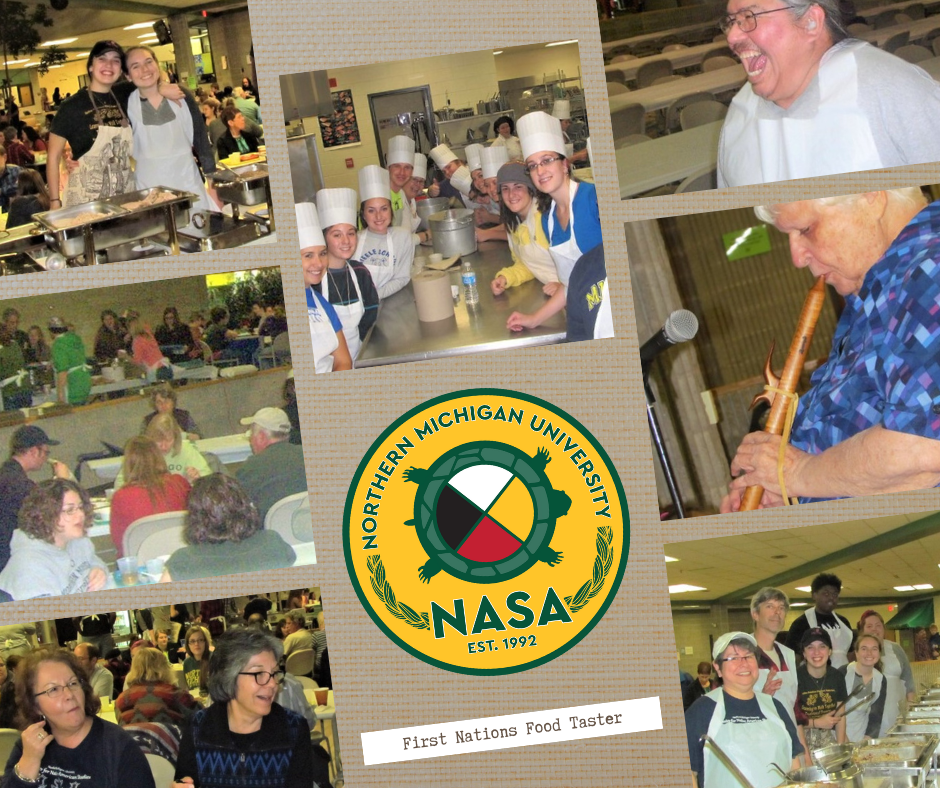 NMU culinary arts professor, Chris Kibit, has been instrumental to the success of the FNFT by providing guidance, use of the culinary arts kitchen, and volunteers from his program. The NASA members recruit other volunteers from the NMU campus and local community to assist with food preparation, serving, and clean-up. The NMU departments and the local business community also plays a part by donating foods, prizes, and monetary support for the student group.
NMU culinary arts professor, Chris Kibit, has been instrumental to the success of the FNFT by providing guidance, use of the culinary arts kitchen, and volunteers from his program. The NASA members recruit other volunteers from the NMU campus and local community to assist with food preparation, serving, and clean-up. The NMU departments and the local business community also plays a part by donating foods, prizes, and monetary support for the student group.
The FNFT had support from community members throughout the years as well. Dr. Elda Tate, retired NMU professor, provided traditional flute music as entertainment for many years at the FNFT. Anishinaabe Ojibwe musicians, Danny Garceau and Frank Montano shared their musical talents. Mitch Bolo acted as Master of Ceremony in making announcements, playing Native music CDs, and assisting with the door prizes. The community drum, Morning Thunder has provided traditional drum songs on multiple occasions.
The Center for Native American Studies
The Center for Native American Studies (CNAS) has been the driving force of Native American initiatives on campus since its inception. It has become the most visible and enduring Native American presence on campus, and has served as a point of entry for people and organizations off campus that are searching for connections to the Native American community.
According to Magnaghi (1999), “It was not until 1991 that Melissa Hearn began to discuss the possibility of having a Center for Native American Studies. The Center was developed on paper and was housed in the English Department where Hearn, and later Lillian Heldreth, served as faculty” (p.291). Magnaghi explains that Hearn and Heldreth “taught in the program and directed two advisory boards” (p.291).
According to Magnaghi (1999), “In 1993, the Center received a $100,000 grant from the Phillip Morris Foundation for three years. The Center for Native American Studies, which had informally existed in the past, was officially approved by the Board of Control on December 13, 1996” (p.291).
Prior to moving to the newly renovated Whitman Building in August of 2003, the CNAS was housed in three office spaces located on the 3rd floor of Magers Hall. The CNAS now enjoys a space that includes faculty and staff offices, a lobby, a resource room, and shared space in the Whitman Commons where tribal flags and Native artwork are displayed. Included in the renovation was the creation of a fire site in the wooded area adjacent to the Whitman parking lot. The fire site is intended for academic, ceremonial and cultural purposes.
CNAS Courses and Academic Programs
According to Magnaghi (1999), “Seminars, workshops and courses were...presented on reservations in the Upper Peninsula” (p.291), but in 1971, the first on-campus courses focusing on American Indian content were introduced. Dr. Marla Buckmaster introduced a field archaeology course in anthropology that focused on sites in Michigan (Magnaghi, 1999, p.25), and Dr. Russell Magnaghi began teaching a course that focused on American Indian history (p.291). Magnaghi (1999) explains that the plans for the current Native American Studies program go all the way back to this era, but the proposal was never approved until much later (p.291).
A minor in Native American Studies was established in 1992 as an interdisciplinary program with courses primarily in Native American studies, art and design, English, history, and anthropology. The minor was restructured twice since it was originally created with the addition of new course offerings and capstone requirements.
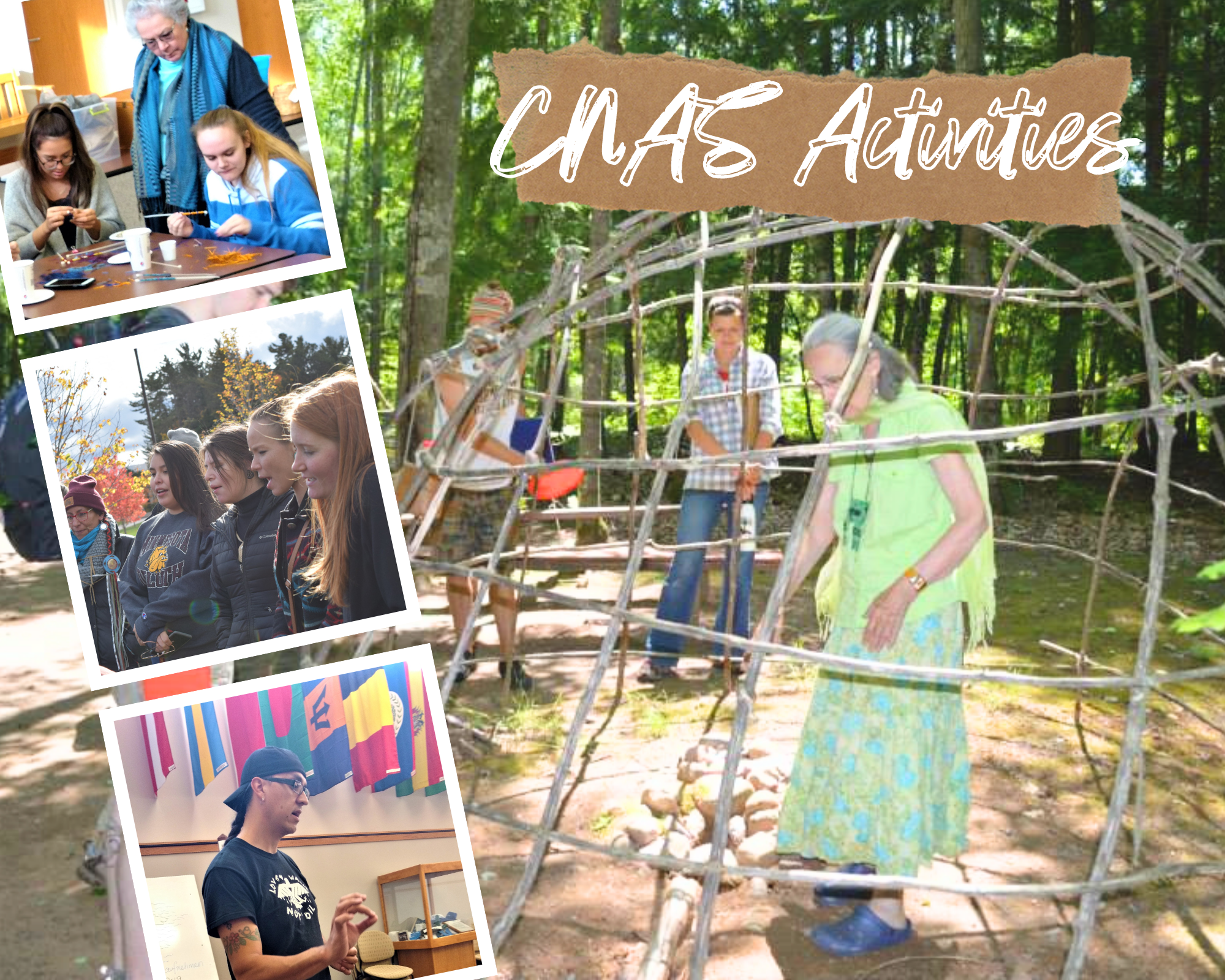
An American Indian Education Certification (AIEC) program was developed in 2011 and was subsequently endorsed by the Tribal Education Departments National Assembly (TEDNA). TEDNA is a national intertribal organization made up of tribal education agency representatives across the United States. This was the first program of its kind ever endorsed by TEDNA. The AIEC was recently restructured to meet new TEDNA standards and is now called the Native American Education Certification (NAEC) program.
In 2011, the CNAS, in partnership with the School of Education, Leadership and Public Service, also contributed two courses towards the development of a master of arts degree in educational administration with an emphasis on American Indian education. This program was also endorsed by TEDNA.
In 2015, the CNAS submitted a proposal to the Academic Senate regarding the establishment of a Native American Studies Major (42 cr.). With only a few exceptions, members of the Senate supported this proposal. The major officially became part of the CNAS program offerings in 2016. This is the first major solely dedicated to the discipline of Native American Studies in the State of Michigan.
The first students graduated with a major in NAS in Fall of 2016. They included Rachel McCaffrey, Trevor Marquardt, and Caitlin Wright. Reinhardt was selected by the NMU student body as the recipient of the first Student’s Choice Award and served as Commencement Speaker for the Fall 2016 ceremony. The Morning Thunder Drum group sang an eagle honor song for the graduates, and the TEDNA Eagle Staff was displayed on the stage during the ceremony.
In 2018, the CNAS developed a new minor called the Native American Community Services (NACS) Minor and an associate of science degree in Native American Community Services, both in partnership with the Social Work Department. This was part of an Office of Victims of Crime grant.
CNAS Staff
Dr. Dennis Tibbetts began his time at NMU in 1996 as the first director of the CNAS on a part- time basis along with his faculty position in the School of Education. Dr. Tibbetts introduced the initiative, the Moccasin Blessing; this event was recognized as a way to start of the academic year in a good way. Dr. Tibbetts also introduced the initiative; the Gekandaasajik alumni association to recognize outstanding NMU Native American Alumni. Dr. Tibbetts also hosted American Indian Law Day at NMU. Tibbetts was instrumental in creating the first, and so far the last, Native American admissions counselor position. In the fall of 1998, April Lindala, who also served as advisor to the Native American Student Association, filled the counselor position for two years.
After Tibbetts resigned from his position in 2000, Liana Loonsfoot served as the Interim Director of the Center until Dr. Martin Reinhardt was hired to fill the position in 2001 as the first full-time director of the Center for Native American Studies. Reinhardt served in this position until 2005.
One of Reinhardt’s first actions was to secure resources for the creation of an assistant director position for the Center. In 2002, Traci Maday was hired as the first, and so far the last, assistant director of CNAS. This was made possible through collaboration between the CNAS and the NMU Charter Schools office. Maday was a liaison between the Center, the Charter Schools office and the two tribal charter schools at Hannahville Indian Community and Sault Ste. Marie Tribe of Chippewa Indians. Maday left NMU in June of 2005.
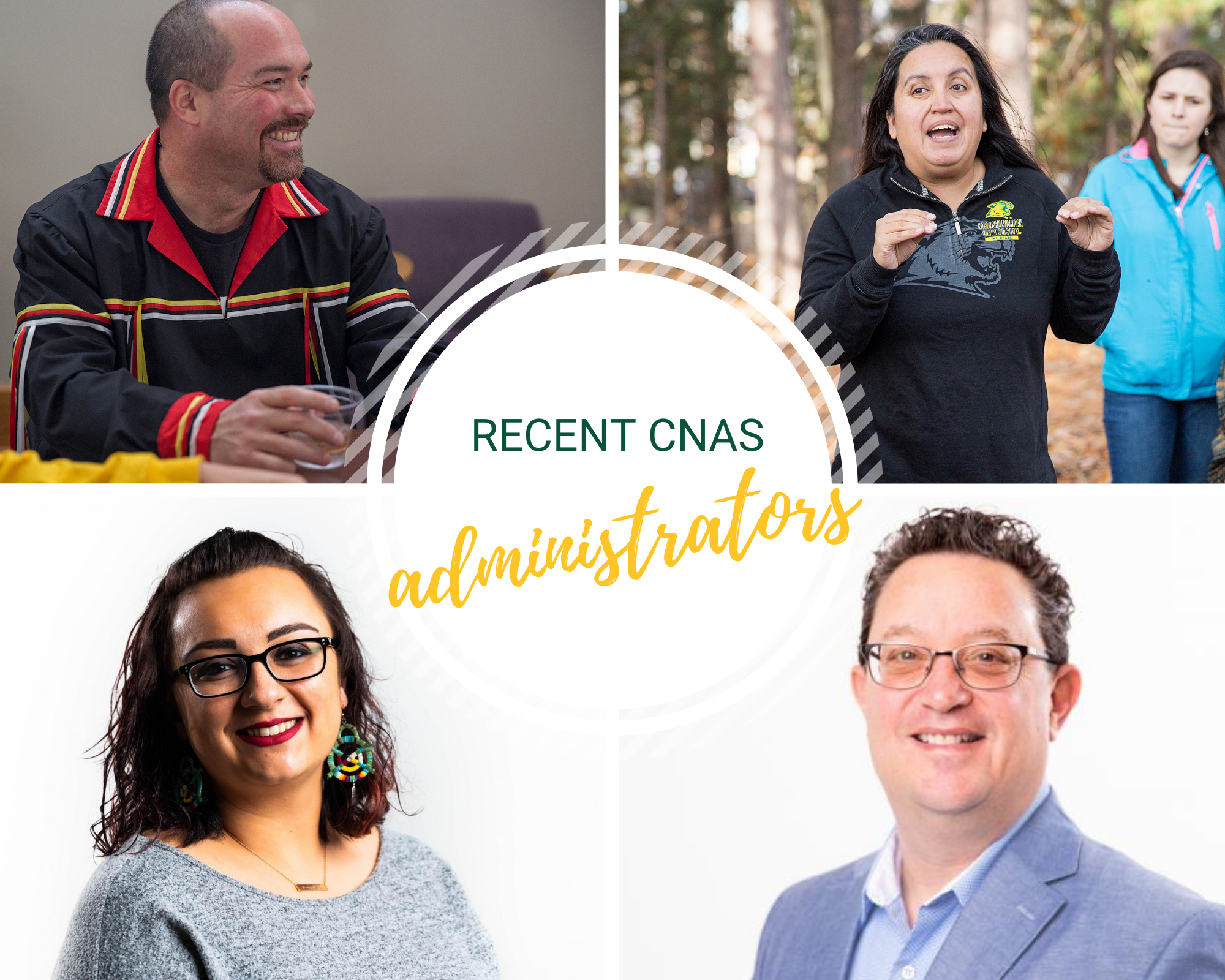
In January 2005, April Lindala accepted the Interim Director position when Reinhardt resigned his position. In May 2007, Lindala would serve the Center as the permanent Director. Under her direction, the number of NAS course offerings increased to more than thirty distinct courses including History of Indian Boarding School education, Indigenous Environmental Movements, American Indians: Identity and Media Images and more. Additionally, Lindala oversaw and implemented multiple on-going or one-time initiatives during her thirteen years as director: the Elders-in-Residence Initiative, the Native American Enrollment Growth Initiative, the Native American Student Empowerment Initiative; the Native American Cultural Programs initiative; the Upper Peninsula Indian Education Conference; the Zaagkii Ethnobotany Website Project; the Widoktaadwin: the Walking in Balance Conference; the Waaseyaasibii’ige: Writing with Light project, a Violence Prevention workshop, and the Indigenous Language Teachers’ workshop. Lindala also co-directed or supervised multiple initiatives for Native American prospective students including two Spring Break Road Warriors trip; multiple financial literacy workshops with Dr. Tawni Ferrarini, the College Prep Medicine Wheel Academy with Dr. Adriana Greci Green, and the Mikwendaagozi: To Be Remembered Project with Kristine Granger. Lindala served as director until the summer of 2019 when she assumed full-time duties as CNAS faculty. Dr. Martin Reinhardt returned to NMU in the fall of 2010 as a full-time faculty member, and served as the interim director of the CNAS from 2019-2020.
Amber Morseau began as the director of CNAS in December of 2020. With Morseau’s hire the directorship duties were split from department head. The duties of department head were transferred to Dr. Joe Lubig who also serves as the Associate Dean for the School of Education, Leadership and Public Service. Morseau began the Red Dress Installation in honor of Missing and Murdered Indigenous Women (MMIW) as an annual CNAS activity, as well as assisting in the development of a social studies resource manual for teachers in the State of Michigan called Mawndoonganan. Morseau resigned from the directorship in June of 2022 and will forever be known as the director who saw the CNAS through the COVID years.
 Stephanie Rousseau, Sally Roo, Christi Etelamaki, Cindy Kleinschmidt, Terri Williams, Tina Moses, Linda Popovic, Karli Jenshak, and Tom Beckett have all served as the principal secretary for the CNAS over the years. Tina Moses also served as an advisor for the Native American Student Association and was awarded a grant to update the CNAS Resource Room.
Stephanie Rousseau, Sally Roo, Christi Etelamaki, Cindy Kleinschmidt, Terri Williams, Tina Moses, Linda Popovic, Karli Jenshak, and Tom Beckett have all served as the principal secretary for the CNAS over the years. Tina Moses also served as an advisor for the Native American Student Association and was awarded a grant to update the CNAS Resource Room.
CNAS Student Workers
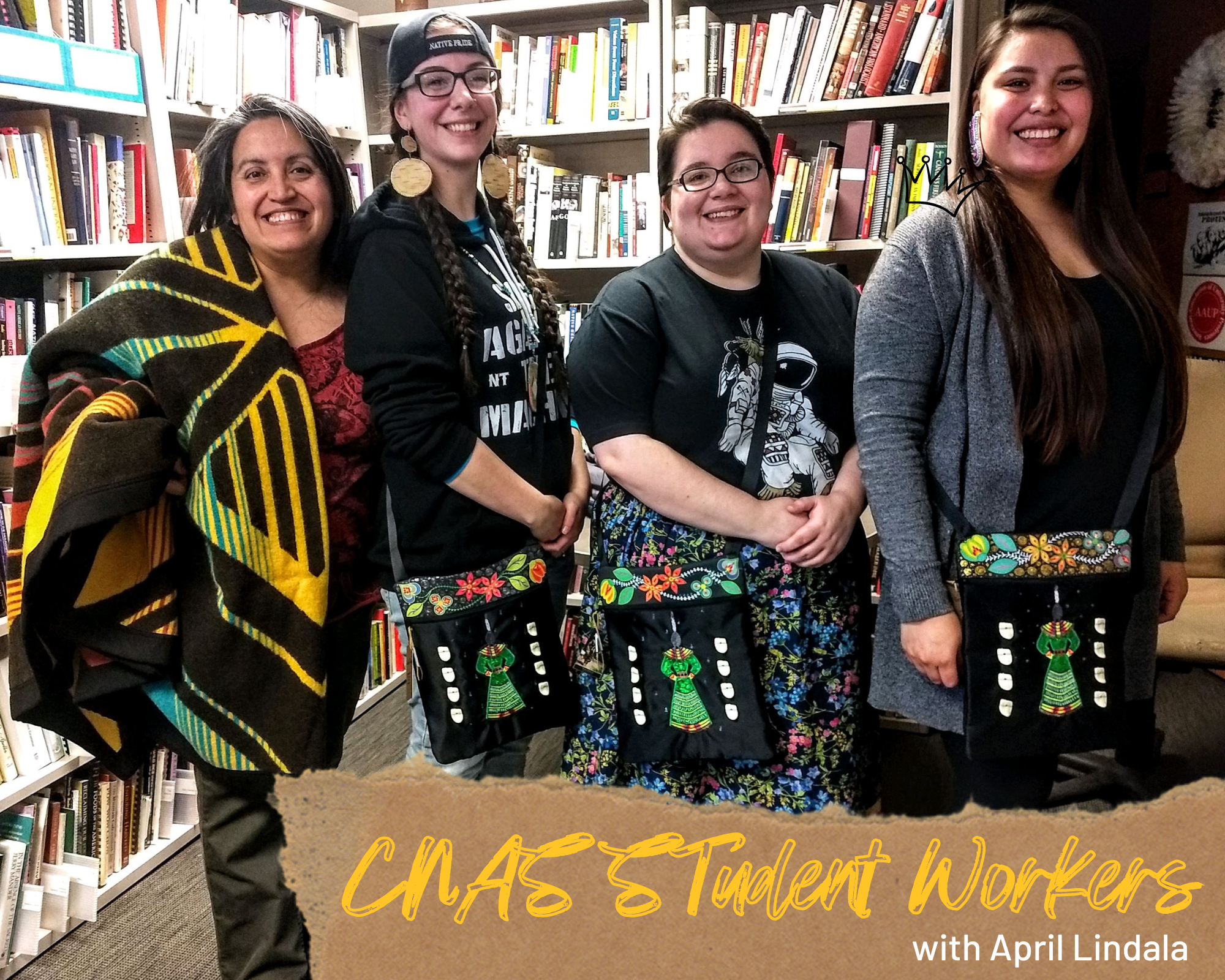
The CNAS has employed many student workers over the years. These students have worked at the CNAS as office and graduate assistants, and peripherally to the Center as camp staff, drivers, or other CNAS activity helpers. Although a comprehensive list is beyond this chapter, a partial list is included below and students not appearing in this list are encouraged to contact the CNAS to amend the record.
Student workers in the CNAS over the years have included: Pam Abel, Dorthy Anderson, Dave Anthony, Sara Antoine, Kayla Bell, Holly Berkstresser, Shelby Boggs, Betty Jo Boscoe, Charlene Bressette, Lisa Boyd, Reese Carter, Morgan Ciecko, Anthony Cergnul, Diana Chan, Summer Cohen, Larry Croschere, Marie Curran, Logan Delke, Evan Dunbar, Reina Eastman, Topher Fast, Ana Fernandez, Spencer Fraley, Lisa Fuqua, Hannah Garcia, Marlee Gunsell, Eric Heiserman, Lexi Ham, Sam Hasek, Sam Hill, Katelyn Hower, Mallory Huizenga, Miranda Hurtado, Ryan Johnsen, Andreaka Jump, Sarah Katt, Ginny Kilpela, Suzette LaCasse, Anna Lang, Brandon LaVictor, Andrew Lorinser, Joey Lubig, Olivia Lubig, Joe Masters, Megan Mathews, Rachel McCaffrey, Trystan McKeel, Daraka McLeod, Lisa McGeshick, Craig Meshigaud, Molly Meshigaud, Heather Naigus, Chad Nedeau, Bazile Panek, Tanner Parish, Mark Pero, David Pitawanakwat, Biidaaban Reinhardt, Nim Reinhardt, Beth Riutta, Jacob Roberts, Shelby Segerstrom, Grey Shea, Andi Shepherd, Leora Tadgerson Lancaster, Levi Tadgerson, Betsy Trudeau, Marisa Van Zile, Levi Warnos, Gabe Waskiewicz, Amanda Weinert, Max Wojciechowski, Steve Wynne, Scott Wyzlic, Zach Ziegler, and Tanya Zorza.
CNAS Faculty
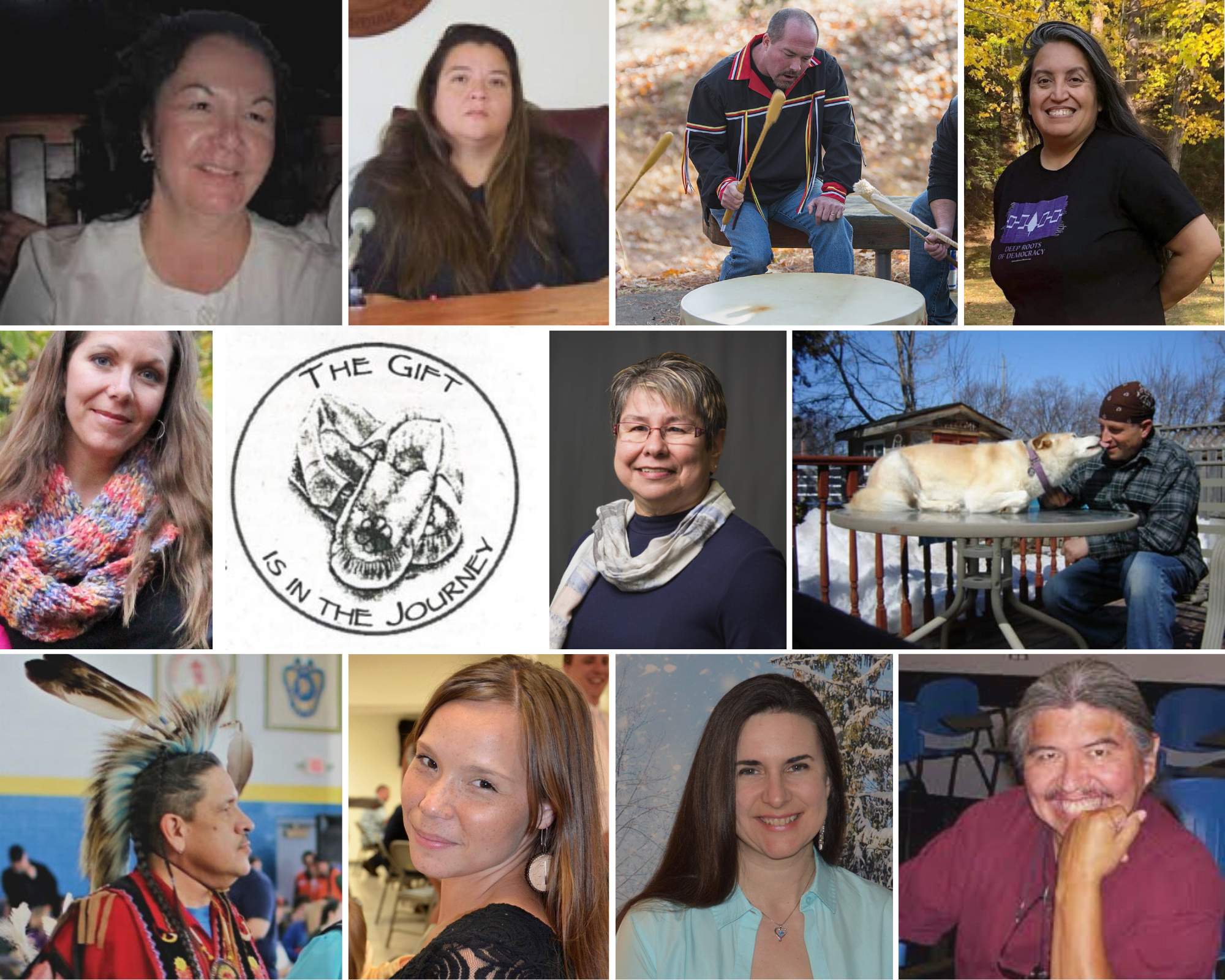
Throughout the years, the CNAS has been home to full-time, contingent, and adjunct faculty. According to Magnaghi (1999), “The first full-time Native American faculty member was Don Chosa, hired in 1993 to teach Anishinaabemowin” (p,291). Chosa was also the first faculty member housed within the Center for Native American Studies. Additional full-time faculty of CNAS have included Dr. Adriana Greci Green, April Lindala, Kenn Pitawanakwat, Dr. Martin Reinhardt, and Dr. Jud Sojourn.
In 2010, Dr. Martin Reinhardt returned to NMU as the first tenure track faculty member in Native American Studies. He was awarded tenure and promoted to associate professor in 2015, and promoted to professor and awarded a sabbatical in 2018. April Lindala was awarded rank of full professor in Native American Studies in 2019.
Contingent faculty that have served in CNAS include Shirley Brozzo, Grace Chaillier, Aimee Cree Dunn, Violet Friisvall-Ayres, Jamie Kuehnl, and Leora Lancaster. Adjunct faculty have included: Don Abel, Tom Biron, Louis Councillor, Valoree Gagnon, Jon Magnuson, Leann Miller Penny Olson, and Helen Roy.
Faculty pictured here (left to right): Grace Chaillier, Violet Friisvall, Martin Reinhardt, April Lindala, Jaime Kuehnl, Shirley Brozzo, Jud Sojourn, Don Chosa, Leora Tadgerson, Aimee Cree Dunn, and Kenn Pitawanakwat.
Interdisciplinary NAS Faculty
Interdisciplinary faculty that have taught Native American studies related courses for departments other than CNAS have included the following; Dr. Bill Bergman, Dr. Marla Buckmaster, Dr. Amy Hamilton, Dr. Melissa Hearn, Allison Hedge Coke, Dr. Lillian Heldreth, Dr. Patricia Killelea, Dr. Steve Leuthold, Dr. Gabe Logan, Dr. Russell Magnaghi, Dr. Stephanie McKenzie, Dr. Rebecca Mead, Dr. Alex Ruuska, Dr. Eileen Roberts, Dr. James Spresser, Dr. Elda Tate, and Dr. Dennis Tibbetts.
CNAS Advisory Board
The CNAS Advisory Board was formed initially to assist Dr. Melissa Hearn and Dr. Lillian Heldreth as they developed plans to create the CNAS. After the CNAS was approved, Board responsibilities included reviewing CNAS activities and providing advice and referral for continuing CNAS growth and development. Over the years CNAS Advisory Board members included NMU faculty, staff, students, alumni, and community members. The CNAS eventually transitioned away from an Advisory Board with the advent of the Faculty Affairs Committee.
CNAS Faculty Affairs Committee
The CNAS Advisory Board created the Faculty Affairs Committee, made up of full-time faculty from various departments at NMU in the fall of 2005. The Faculty Affairs Committee (FAC) was designed to serve as a department’s executive committee. Since the Center was not an Academic Department, it was necessary to add such a component to the already existing CNAS Advisory Board. Contingent CNAS faculty members were later added to the membership of the FAC.
Dr. Amy Hamilton, Michael Letts, Dr. Gabe Logan, Dr. Judith Puncochar, Dr. Martin Reinhardt, and Dr. Jud Sojourn have all served as the chair or co-chair of FAC. In 2012, Dr. Martin Reinhardt was elected to chair the FAC, marking the first time that CNAS faculty filled that role since the FAC was created. Reinhardt remained chair until 2018 when Dr. Amy Hamilton and Dr. Jud Sojourn began serving as co-chairs of the FAC. Dr. Jud Sojourn is the current chair of FAC.
Other members of the FAC have included: Shirley Brozzo, Grace Chaillier, Aimee Cree Dunn, Dr. Scott Demel, Dr. Steve DeGoosh, Dr. Don Faust, Dr. Mollie Freier, Dr. Brandon Gerig, Dr. Sheri Giordana, Robert Lalonde, Dr. LaMart Hightower, Dr. Timothy Hilton, Michelle Johnson, Dr. Patricia Killelea, Jamie Kuehnl, Dr. Janet Labron, Michael Letts, April Lindala, Dr. Carolyn Lowe, Dr. Russ Magnaghi, Dr. Rebecca Mead, Dr. Jacquie Medina, Dr. Sarah Mittlefehldt, Dr. Kenny Mullins, Dr. Erich Ottem, Kenn Pitawanakwat, Dr. Alex Ruuska, Dr. Don Rybacki, SaraJane Tompkins, Tracy Wascom, Dr. Carl Wozniak, and Dr. Yan “Sunny” Xingzhong.
CNAS Academic Senate Representatives
In 2012, the Academic Senate Bylaws were revised to allow the CNAS to have representation on the Senate. Dr. Martin Reinhardt was elected by his peers on the CNAS FAC to serve in that capacity. He served until 2018. Dr. Jud Sojourn served as the CNAS representative from 2018 2021, and April Lindala has been serving in this capacity since.
Native American Commencement Speakers
According to Magnaghi (1999), “On a number of occasions, Native American persons were awarded honorary degrees from Northern: Beatrice Medicine (Humane Letters, 8/79), Vine Deloria, Jr. (Humanities, 5/1991), and LaDonna Harris, (Humanities, 4/1994)” (p. 291). Ada Deer was the last to be awarded an honorary degree (Humanities, 4/2012). The last three individuals were also commencement speakers. Martin Reinhardt was selected as the most recent Native American person to act as commencement speaker at NMU (12/2016) but did not receive an honorary degree. Reinhardt was selected by the graduating NMU students to be the commencement speaker.
Other CNAS Programs
The history of the CNAS summer youth programs and the history of the Hannahville Indian School/Nah Tah Wahsh Public School Academy began as separate entities but merged in the early 2000s. The Hannahville programs began back in 1987 as part of Project Blueprint, which was developed by Rich Sgarlotti with assistance from Tom Biron and others. Interestingly enough, this project was developed as a collaboration between NMU and Hannahville Indian School, but was administered by the latter.
The CNAS has worked with several organizations over the years to provide summer youth programs. Included among the programs we have sponsored or supported throughout the years: American Indian Youth Workshop hosted by Michigan Technological University; Anishinaabe Future Leaders Workshop hosted by the Intertribal Council of Michigan; College Day/GEAR Up Summer Program hosted by NMU Multicultural Education and Resource Center; National Indian Youth Leadership Workshop hosted by Hannahville Indian School; Protectors of the Earth hosted by Sault Tribe Youth Program; and Onji-Akiing hosted by Great Lakes Indian Fish & Wildlife Commission.
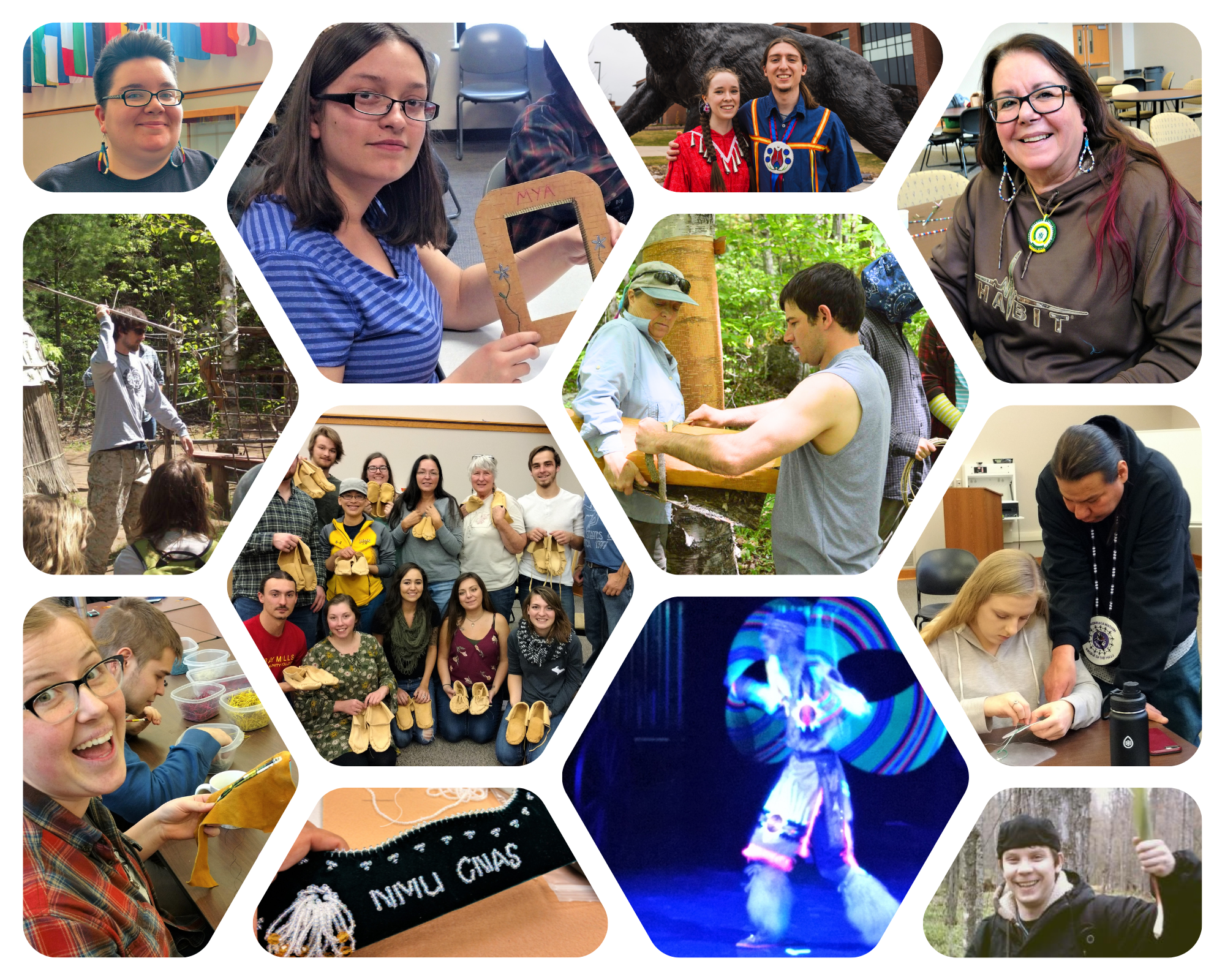
Other projects that the CNAS has been involved in over the years have largely been grant funded and have focused on environmental and social justice and Indigenous education models. CNAS grant writing efforts, especially those of April Lindala, have proven successful in providing support for the following projects:
• Earl’s Wigwam (2005) was a video produced by the CNAS in partnership with Earl Otchingwanigan and the Hannahville Indian School. It documents the creation of a traditional Anishinaabe wigwam from start to finish.
• The Zaagkii (That Which Comes from the Earth) Project was co-sponsored by the Cedar Tree Institute and engaged local youth in cultural and environmental revitalization efforts in the surrounding community including pollinator protection.
• The Medicine Wheel Academy was an internal NMU grant in collaboration with other NMU departments to provide high school students with an opportunity to learn about health and science professions.
• Voice on the Water: Great Lakes Native America Now is an anthology collection of stories poems and images of contemporary Native people living in Michigan. Grace Chaillier and Rebecca Tavernini were the editors of the anthology.
• The Creating and Learning Art in Native Settings (CLANS) project provided students with multiple opportunities to engage in traditional arts and crafts in tribal community settings.
• The Decolonizing Diet Project (DDP) was a multi-dimensional research project that focused on the relationship between people and Indigenous foods of the Great Lakes Region. Results of the DDP provide statistically significant and noteworthy data regarding the positive health consequences of eating local Indigenous foods. The Decolonizing Diet Project Cookbook (2018) was produced and is available through the CNAS. Martin Reinhardt, Leora Lancaster, April Lindala, and Tina Moses were the editors of the cookbook.
• The Indigenous Women Working within the Sciences (IWWS) pilot project provided a range of activities and events around the theme “Reimagine STEM.” This National Science Foundation sponsored grant funded a three-part program that included a STEM Youth Academy, a STEM Educators Institute, and a Fall Retreat for Educator Mentors.
• The Serving Native Survivors Circle is a three-year project that seeks to increase internship opportunities and other incentives for NMU students wanting to work in the field of social work in tribal communities.
• The Anishinaabe Language Learning Community (ALLC) Project is designed to expand Anishinaabe language course offerings at both undergraduate and graduate levels. The ALLC project directly addresses the need to develop distinct curriculum designed to further Anishinaabe language learning opportunities.
• The Indigenous Earth Issues Summit was an annual event for several years beginning in 2008. Designed as a call to action, presenters focused on Indigenous perspectives on contemporary environmental issues in the region, on Turtle Island, and around the world. Keynotes came from Anishinaabe Aking and as far away as the South Pacific and the Artic; they included award winning Anishinaabe author Jim Northrup, Bad River Tribal Chairman Mike Wiggins Jr., an Aboriginal Australian Delegation (John Hunter, Victor Steffensen, Barry Hunter, and Brad Lewis as well as Bay Mills tribal citizen Bucko Teeple), outspoken and ostracized historian Ward Churchill, renowned Gwich’in climate activist Evon Peter, and award-winning Chickasaw author Linda Hogan.
• The Seventh Fire Project was a multi-year, grant-funded traveling presentation program offered free to communities, colleges, high schools and middle schools. Rooted in the teachings of the Seven Fires, it presented students and community members with Indigenous perspectives on contemporary environmental issues and Indigenous values-based solutions for how to return to a respectful relationship with all our relations.
• The UP Indian Education Conference began in 2001 as an annual event. The last one was held in 2011. This event featured presentations and workshops focused on tribal education departments, tribal schools, and tribal colleges in Michigan’s Upper Peninsula.
NMU/CNAS Honors
Besides the endorsements from TEDNA, NMU has received the honor of being one of the top 200 Native American student-serving institutions in the United States. This was largely based on the work of the CNAS.
Native American Student House
In 2001, Housing and Residence Life at NMU designated a portion of West Hall as a Native American themed student house. Native American students had the option of choosing to live in the house which included Native American themed activities supported by the CNAS and other NMU departments and organizations. Ultimately, nine students chose to take part in the experience.
It was during this time period, and directly related to the Native American house, that an exception to open flame policy was added to the NMU Student Handbook. Until that point, students were not allowed to smudge in any of the housing units. April Lindala and Martin Reinhardt joined Anishinaabe student Pam Abel in requesting that an exception be made for ceremonial or religious purposes. The exception was granted and is now encoded in Section 2.3.7(.02) of the NMU Student Handbook under "Dangerous Materials and Open Flame": "No students shall use or create an open flame or use live or glowing embers or charcoal on University premises. Residents living in on-campus apartments shall be permitted to use small propane tank (not to exceed 16.4 oz.) grills outside. This regulation shall not apply to faculty-member supervised learning activities. Requests for exception to this regulation for ceremonial or religious purposes may be made to the Dean of Students or designee."
Student interest in the Native American house waned in 2004 and the house was discontinued although the exception to the Open Flame policy remains in effect.
Land Acknowledgment and Seventh Fire Exhibition
In 2020, CNAS was involved in two major projects that would greatly highlight the Indigenous presence on campus and in the region. The first was the development of a land acknowledgement sign in the center of campus. Joining CNAS in this effort were members of NASA, the Beaumier U.P. Heritage Center, the Department of Sociology and Art & Design. Over the next year, the language, location and design of the sign were finalized. Designed by NASA member and design student, Reese Carter, the sign was placed along the walkway between Jamrich Hall and the Thomas Fine Arts Building. It was unveiled on Indigenous People’s Day on October 11, 2021. In addition to the sign, the university has set aside the forest area adjacent to the sign to be developed as a Anishinaabe interpretive walk which will be developed in the near future.
In addition to this project, CNAS was deeply involved in the development of a new exhibition that was featured at the Beaumier Center’s gallery from October 2021 through April 2022. Entitled, “The Seventh Fire,” the exhibition looked at not only the history of the Anishinaabe but also their efforts towards self-determination and hopes for decolonization. CNAS staff and faculty Martin Reinhardt, April Lindala, Amber Morseau, Jud Sojourn and Leora Tadgerson assisted with the development of the exhibition’s narrative message. In addition, Bazile Panek and Ursa Peterson from NASA were part of the exhibition committee. Reese Carter designed the font and much of the graphic material for the exhibition. The exhibition is now being developed as a touring display which will travel to pow wows and Anishinaabe cultural centers around the region.
Up North Films
Up North Films is a non-profit, documentary film production company at NMU that was founded by Dr. Michael Loukinen. His team produced 15 films over the last 35 years, including six titles focused on Native American themes. The Native American themed films include: Ojibwe Drum Songs; Ojibwe Birchbark Wigwam; Manoomin (Wild Rice): Ojibwe Spirit Food; Anishnaabe Gikinoo'amaadiwin (Ojibwe Teachings); McGeshick Family Stories; and Medicine Fiddle.
Conclusion
From the land upon which it was built to the advent of the first major in Native American Studies in the State of Michigan, the history of Native American initiatives at Northern Michigan University has been witness to the stories of many people. Students, faculty, staff, and community members have contributed their time and energy toward academic programs, cultural events, youth programs, and research projects. Several times throughout its history, NMU has taken a lead on addressing issues that significantly impact Native American communities. It has also been a place where Native people can find community. This has contributed to the recognition of NMU and the CNAS as leaders in Native American higher education.
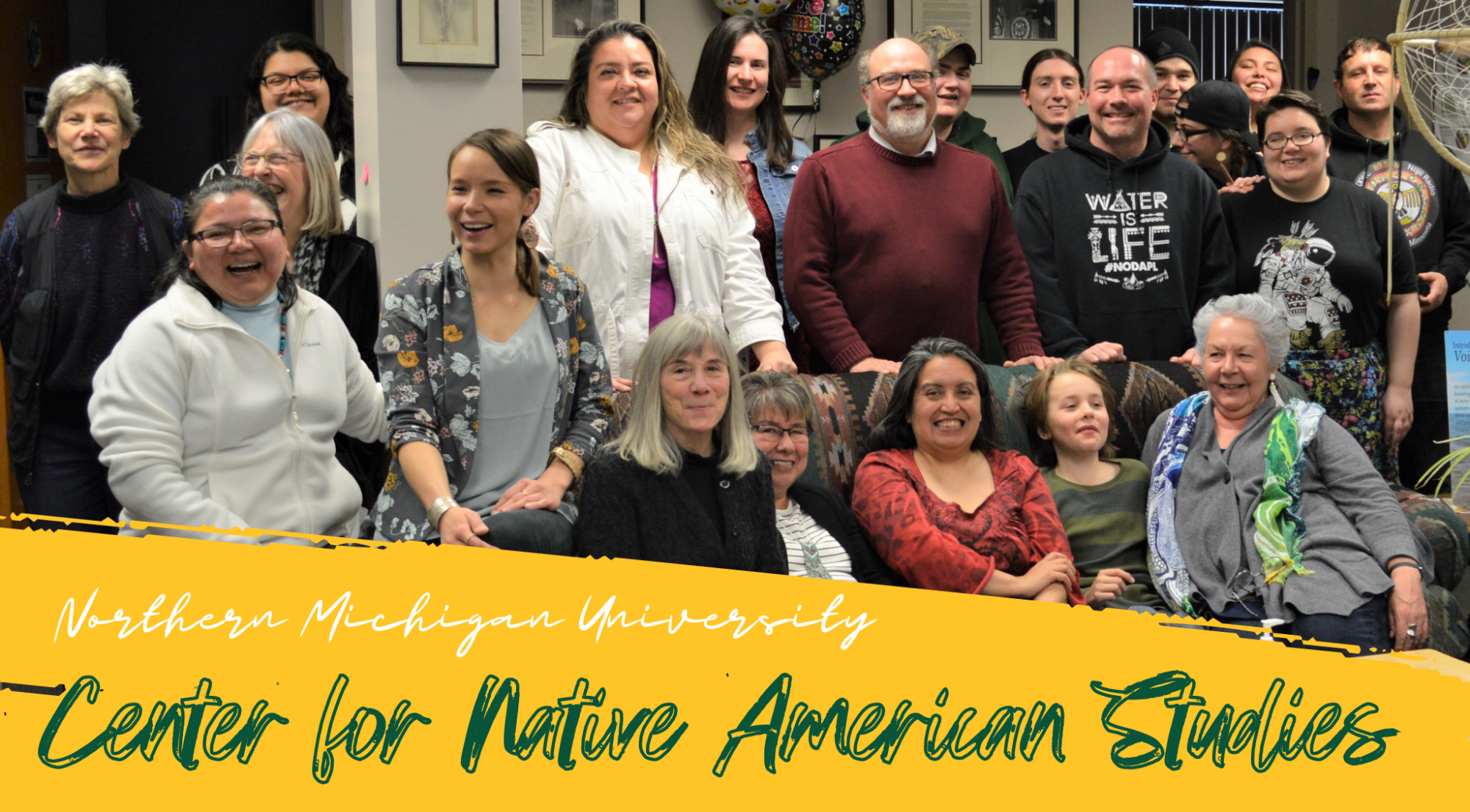
References
Chaillier, G. and Tavernini, R. (eds). (2011). Voice on the Water: Great Lakes Native America Now. Marquette, MI: Northern Michigan University Press.
Great Lakes Indian Fish & Wildlife Commission. (2007). Map of Traditional Place Names in the Upper Great Lakes.
Magnaghi, R. (1999). A Sense of Time: The Encyclopedia of Northern Michigan University. Marquette, MI: Northern Michigan University Press.
Magnaghi, R. (2009). Native American of Michigan's Upper Peninsula: A Chronology to 1900. Marquette, MI: Northern Michigan University Center for Upper Peninsula Studies.
Mashkiig (n.d.) In Ojibwe People’s Dictionary. Retrieved from https://ojibwe.lib.umn.edu/searchutf8=%E2%9C%93&q=mashkiig&commit=Search&type=ojibwe
Mashkiki (n.d.) In Ojibwe People’s Dictionary. Retrieved from https://ojibwe.lib.umn.edu/searchutf8=%E2%9C%93&q=mashkiki&commit=Search&type=ojibwe
Northern Michigan University. (n.d.) Center for Native American Studies website. https://www.nmu.edu/nativeamericanstudies/
Reinhardt, M. (1998). The Pre-Legislative History of the Michigan Indian Tuition Waiver. Unpublished master’s thesis, Central Michigan University, Mt. Pleasant, Michigan.
Reinhardt, M., Lancaster, L., Lindala, A, and Moses, T. (eds). (2016). Decolonizing Diet Project Cookbook. Featuring Indigenous food recipes from the Great Lakes Region. Marquette, MI: Northern Michigan University, Center for Native American Studies.
Sault Ste. Marie Evening News (EN), page numbers were not maintained:
Jun. 19, 1957. “Proposal to End Control on Indian Land Outlined.”
Sep. 17, 1965. “Claims State Doing Nothing to Aid Peninsula Indians.”
Aug. 13, 1968. “Film Highlights Indian Affairs Session.”
Sep. 26, 1972. “Mike Wright Named to AIPA Director’s Board.”
